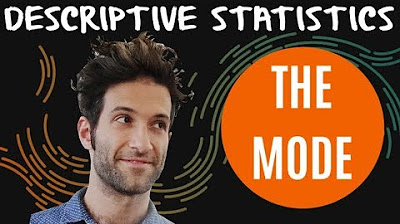Computing Central Tendency (Mean, Median, Mode) in JASP (5-9)
TLDRThis tutorial demonstrates how to calculate central tendency measures—mean, median, and mode—using JASP with the StatsClass.SAV dataset. It explains the process of opening the dataset, selecting variables, and interpreting the results to determine the normality of distributions. The video also introduces additional JASP features, such as histograms, density curves, Q-Q plots, and the ability to split analyses by categorical variables. The session concludes with saving the analysis as a JASP dataset for future reference.
Takeaways
- 📚 The video script provides a tutorial on calculating central tendency measures using JASP with the StatsClass.SAV dataset.
- 💻 JASP can open SPSS .SAV files and CSV files directly, but not Excel files, which need to be converted to CSV first.
- 📊 The central tendency measures include mean, median, and mode, which are descriptive statistics and can be accessed through the 'Descriptive Statistics' menu in JASP.
- 🔍 To determine if a variable is normally distributed, one should look at the similarity between the mean, median, and mode of the data.
- 📈 The script uses IQ scores as an example of a normally distributed variable, showing that its central tendency measures are very close.
- 📉 Attitudes towards statistics serve as an example of a non-normally distributed variable, with central tendency measures that are quite different.
- 📊 JASP allows users to visualize data distributions with histograms and density plots, which can confirm the normality of a distribution.
- 📈 The histogram and density plot of IQ scores in the script resemble a normal distribution, indicating that it satisfies the assumption of normality.
- 📉 For the attitudes towards statistics, both the histogram and density plot do not resemble a normal distribution, confirming its non-normality.
- 🔧 JASP's progressive disclosure feature makes it easy to add or remove plots and analyses without disrupting the existing setup.
- 📊 Additional plots like correlation plots, box plots, and Q-Q plots can be added in JASP to further analyze and visualize data distributions.
- 💾 The script concludes with instructions on how to save the JASP file, which includes the dataset and all analysis and plotting done so far.
Q & A
What are the three measures of central tendency mentioned in the script?
-The three measures of central tendency mentioned are mean, median, and mode.
How does one open an SPSS data set in JASP?
-In JASP, you can open an SPSS data set by going to the Main Menu icon -> Open -> Computer -> Desktop, and then selecting the .SAV file.
What file formats can JASP directly open for analysis?
-JASP can directly open .SAV and CSV file formats for analysis, but not Excel files, which need to be converted into .CSV first.
What does JASP's progressive disclosure feature allow users to do?
-JASP's progressive disclosure feature allows users to see the results as soon as they enter the variables, without having to wait for the entire analysis to complete.
How can one determine if a variable is normally distributed based on the script?
-One can determine if a variable is normally distributed by comparing the mean, median, and mode. If these measures are very similar, it suggests normal distribution.
What does the script suggest about the distribution of 'IQ' scores?
-The script suggests that the 'IQ' scores are normally distributed because the mean, median, and mode are very close to each other.
How can histograms and density curves help in understanding the distribution of a variable?
-Histograms and density curves provide visual representations of the distribution of a variable, helping to identify whether it is normally distributed or not.
What additional plot does the script mention for analyzing the distribution of variables?
-The script mentions Q-Q plots as an additional tool for analyzing the distribution of variables and determining their normality.
How can JASP help in identifying outliers in a data set?
-JASP can help in identifying outliers through box plots, and by labeling outliers, users can learn their case numbers.
What is the purpose of the 'Split' feature in JASP when analyzing data?
-The 'Split' feature in JASP allows users to examine the scores or results for different groups separately, such as by gender or class standing.
How can users save their analysis and plotting work in JASP?
-Users can save their analysis and plotting work in JASP by going to Save as -> Computer -> Desktop and saving it as a .jasp file, which will contain all the analysis and plotting done so far.
Outlines
📊 Understanding Central Tendency in JASP
This paragraph introduces the process of calculating central tendency measures such as mean, median, and mode using JASP software. It begins with the steps to open the StatsClass.SAV dataset from the desktop and highlights JASP's capability to open SPSS and CSV files directly. The focus is on the 'IQ' and 'StatATT' variables, which are identified as scale level measurements. The Descriptive Statistics feature is used to compute central tendency, with an explanation of JASP's progressive disclosure feature that allows for immediate viewing of results. The paragraph concludes with an examination of the results for both variables, noting the similarity of the measures for IQ scores, suggesting a normal distribution, in contrast to the 'Attitudes towards statistics' scores, which show significant differences, indicating a non-normal distribution. The speaker poses a question about the normality of the distributions and suggests using histograms and density plots for further analysis.
📈 Analyzing Distributions and Additional JASP Features
The second paragraph delves deeper into the analysis of the 'IQ' and 'Attitudes towards statistics' distributions, confirming the normality of IQ scores through the examination of histograms and density plots. It contrasts this with the non-normal distribution of the attitude scores, which are visually distinct from a normal curve. The paragraph also showcases additional features of JASP, such as the ease of adding correlation plots, box plots, and Q-Q plots to further understand the data. The speaker discusses the identification of outliers and the ability to customize plots with elements like color and jitter. The paragraph concludes with a demonstration of JASP's capability to split analyses by categorical variables and save the entire session, including data and analysis, as a JASP dataset file for future reference.
Mindmap
Keywords
💡Central Tendency
💡Mean
💡Median
💡Mode
💡JASP
💡Descriptive Statistics
💡Histogram
💡Density Plot
💡Normal Distribution
💡Outlier
💡Q-Q Plot
💡Progressive Disclosure
Highlights
Learning to compute measures of central tendency: mean, median, and mode using JASP.
Using the data set StatsClass.SAV, which is an SPSS file that JASP can open directly.
JASP's compatibility with .SAV and CSV data sets, but not with Excel files that require conversion to .CSV.
Understanding the level of measurement for variables 'IQ' and 'StatATT' as Scale in JASP.
Using Descriptive Statistics in JASP to analyze central tendency.
JASP's progressive disclosure feature showing results as variables are entered.
Adding mean, median, and mode to the Descriptive Statistics table in JASP.
The distinction between measures of central tendency for 'IQ' and 'Attitudes towards statistics'.
Analyzing the normal distribution of 'IQ' scores based on similar mean, median, and mode.
Identifying that 'Attitudes towards statistics' is not normally distributed due to differing central tendency measures.
Visualizing distributions with histograms and density curves in JASP.
The density curve of IQ scores resembling a normal distribution, indicating normality.
The histogram and density curve of 'Attitudes towards statistics' not resembling a normal distribution.
Adding Correlation Plots in JASP to analyze the relationship between 'IQ' and 'Stats attitudes'.
Using box plots in JASP to identify the spread and outliers in the data.
Experimenting with JASP's plot elements like Color, Violin, and Jitter for clearer data visualization.
Utilizing Q-Q plots in JASP to determine the normality of a distribution.
Customizing JASP output by adding or removing plots and analyses without disrupting the analysis.
Splitting an analysis by a categorical variable in JASP to examine separate scores for different groups.
Saving the JASP file with data, analysis, and plots for future reference.
Transcripts
Browse More Related Video

Histograms and Density Plots with {ggplot2}

Descriptive Statistics: The Mode

Introduction to Statistics

Setting Variables with Levels of Measurement: Discover Statistics with JASP for Beginners (3 of 6)

Mean, Median, and Mode: Measures of Central Tendency: Crash Course Statistics #3

Normal Probability Plots Explained (OpenIntro textbook supplement)
5.0 / 5 (0 votes)
Thanks for rating: